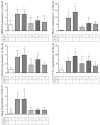Dried plum diet protects from bone loss caused by ionizing radiation
- PMID: 26867002
- PMCID: PMC4750446
- DOI: 10.1038/srep21343
Dried plum diet protects from bone loss caused by ionizing radiation
Abstract
Bone loss caused by ionizing radiation is a potential health concern for radiotherapy patients, radiation workers and astronauts. In animal studies, exposure to ionizing radiation increases oxidative damage in skeletal tissues, and results in an imbalance in bone remodeling initiated by increased bone-resorbing osteoclasts. Therefore, we evaluated various candidate interventions with antioxidant or anti-inflammatory activities (antioxidant cocktail, dihydrolipoic acid, ibuprofen, dried plum) both for their ability to blunt the expression of resorption-related genes in marrow cells after irradiation with either gamma rays (photons, 2 Gy) or simulated space radiation (protons and heavy ions, 1 Gy) and to prevent bone loss. Dried plum was most effective in reducing the expression of genes related to bone resorption (Nfe2l2, Rankl, Mcp1, Opg, TNF-α) and also preventing later cancellous bone decrements caused by irradiation with either photons or heavy ions. Thus, dietary supplementation with DP may prevent the skeletal effects of radiation exposures either in space or on Earth.
Figures







Similar articles
-
Ionizing Radiation Stimulates Expression of Pro-Osteoclastogenic Genes in Marrow and Skeletal Tissue.J Interferon Cytokine Res. 2015 Jun;35(6):480-7. doi: 10.1089/jir.2014.0152. Epub 2015 Mar 3. J Interferon Cytokine Res. 2015. PMID: 25734366 Free PMC article.
-
Dietary dried plum increases bone mass, suppresses proinflammatory cytokines and promotes attainment of peak bone mass in male mice.J Nutr Biochem. 2016 Aug;34:73-82. doi: 10.1016/j.jnutbio.2016.04.007. Epub 2016 May 10. J Nutr Biochem. 2016. PMID: 27239754 Free PMC article.
-
Oxidative stress and gamma radiation-induced cancellous bone loss with musculoskeletal disuse.J Appl Physiol (1985). 2010 Jan;108(1):152-61. doi: 10.1152/japplphysiol.00294.2009. Epub 2009 Oct 29. J Appl Physiol (1985). 2010. PMID: 19875718 Free PMC article.
-
Dried Plums, Prunes and Bone Health: A Comprehensive Review.Nutrients. 2017 Apr 19;9(4):401. doi: 10.3390/nu9040401. Nutrients. 2017. PMID: 28422064 Free PMC article. Review.
-
Irradiation affects the structural, cellular and molecular components of jawbones.Int J Radiat Biol. 2022;98(2):136-147. doi: 10.1080/09553002.2022.2013568. Epub 2021 Dec 16. Int J Radiat Biol. 2022. PMID: 34855558 Review.
Cited by
-
Role of Commodity Boards in Advancing the Understanding of the Health Benefits of Whole Foods: California Dried Plums.Nutr Today. 2017 Jan;52(1):19-25. doi: 10.1097/NT.0000000000000187. Epub 2017 Jan 25. Nutr Today. 2017. PMID: 28216794 Free PMC article.
-
Dietary supplementation of dried plum: a novel strategy to mitigate heat stress in broiler chickens.J Anim Sci Biotechnol. 2021 Mar 30;12(1):58. doi: 10.1186/s40104-021-00571-5. J Anim Sci Biotechnol. 2021. PMID: 33781340 Free PMC article.
-
Biological Protection in Deep Space Missions.J Biomed Phys Eng. 2021 Dec 1;11(6):663-674. doi: 10.31661/jbpe.v0i0.1193. eCollection 2021 Dec. J Biomed Phys Eng. 2021. PMID: 34904063 Free PMC article. Review.
-
Knee and Hip Joint Cartilage Damage from Combined Spaceflight Hazards of Low-Dose Radiation Less than 1 Gy and Prolonged Hindlimb Unloading.Radiat Res. 2019 Jun;191(6):497-506. doi: 10.1667/RR15216.1. Epub 2019 Mar 29. Radiat Res. 2019. PMID: 30925135 Free PMC article.
-
Relative Effects of Radiation-Induced Changes in Bone Mass, Structure, and Tissue Material on Vertebral Strength in a Rat Model.J Bone Miner Res. 2023 Jul;38(7):1032-1042. doi: 10.1002/jbmr.4828. Epub 2023 Jun 4. J Bone Miner Res. 2023. PMID: 37191221 Free PMC article.
References
-
- Kondo H. et al. Shared oxidative pathways in response to gravity-dependent loading and gamma-irradiation of bone marrow-derived skeletal cell progenitors. Radiats Biol Radioecol 47, 281–285 (2007). - PubMed
-
- Alwood J. S. et al. Heavy ion irradiation and unloading effects on mouse lumbar vertebral microarchitecture, mechanical properties and tissue stresses. Bone 47, 248–255 (2010). - PubMed
Publication types
MeSH terms
LinkOut - more resources
Full Text Sources
Other Literature Sources
Medical

